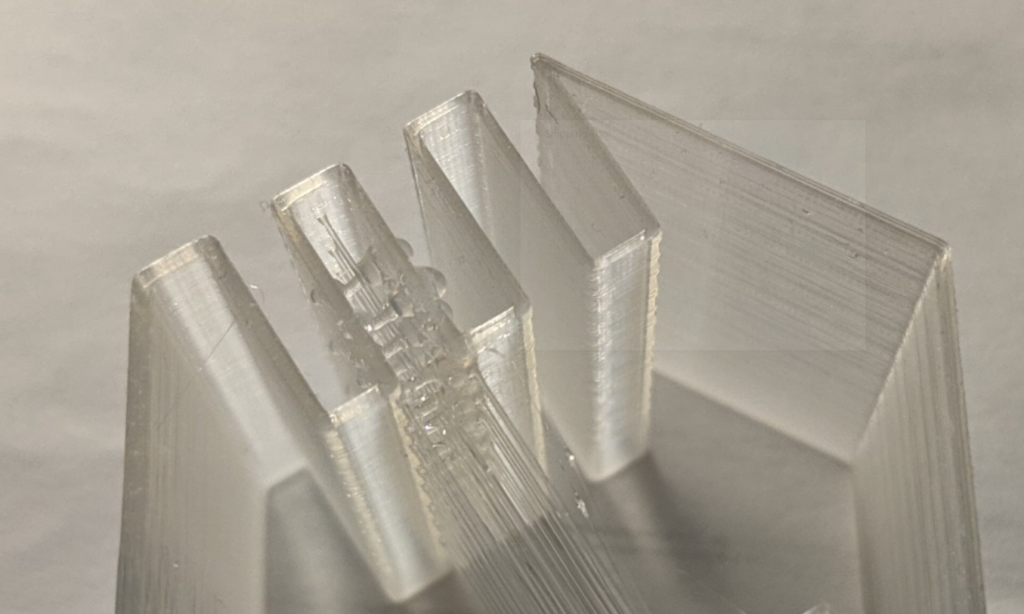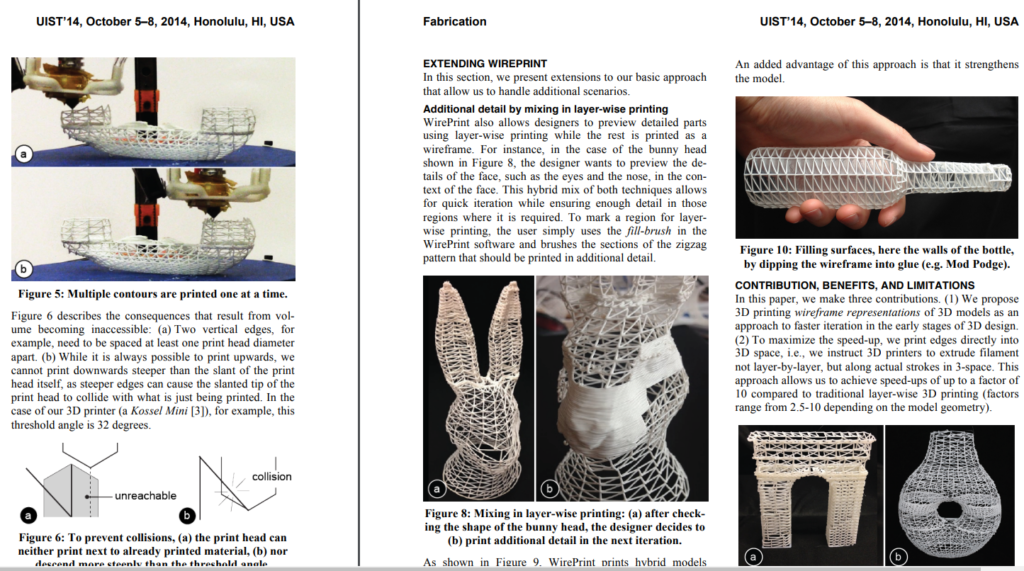Description of my process
My code uses Prof. Leah and Franklin’s “extruder-turtle-Rhino” library to generate g-code. Particularly, all my three prints uses are based on the fiber bridging technique which cannot be generated by a traditional slicer. My code for the first 2 prints, 8x5x5 chessboard and 3d maze, first deposits a layer of the base shape and it set penup and went through the shape again and make a fiber bridge at designed locations. My third print, prototype of a kinetic sculpture, make a fiber bridge at designed locations at the same time as the base shape is deposited. For this 3rd print, my code mimic the draw method of the L system.
In the beginning I have no idea what cannot be generated by a traditional slicer so I started by reading through the references. I am attracted to the bridging technique in “3dprint.com/32480/3d-print-paintbrush-bridging/”. However there is only text description but no code. I then went on to read the “Extruder-Turtle” paper by Prof. Leah and Franklin.
The “Extruder-Turtle” paper analyzed very clearly what cannot be done by traditional slicer. Having a clear idea, I began with examples at Franklin’s webpage. However, some variable definition is missing. Luckily, there is complete demo code at the github repo. But when I tried to run the examples, first, the Rhino viewport showed no lines, then, “cardioid.py” resulted in strange turtle path. Prof. Leah again generously helped me solved both problem: Grasshopper’s python block output “out” cannot be used to display geometries and “cardioid.py”‘s radians have to be changed to degrees.
I am relieved to be able to print the “cardioid.py” generated g-code which have the fiber bridging technique. After first, I got several string art ideas: boat in a bottle, tree houses, etc. But I soon realized and recalled what the “Extruder-Turtle” paper’s “Discussion” section said: “Turtle Geometry’s emphasis on local movement makes it difficult to design prints with complex geometry that lack convenient symmetries or simple low-level descriptions”.
Fortunately, I was able to come up with some interesting ideas to design and print: an 8x5x5 “3D” chessboard, a 3d maze, and a prototype inspired by the kinetic sculpture called “Exercise in Frugality” by artist George Rhoads at Boston’s Logan Airport.
Challenges I encountered
One is there are unexpected blobs of filaments forming on my kinetic sculpture print. I made sure I didn’t repeatedly deposit filament at the same height. Later I found I do too many pendown which might result in many positive extrusions (E3).

Shape 1: 8x5x5 chessboard
I have been trying to come up with an implementation of “3D” chess for a few years. It’s really a nice opportunity for me to see what an actually 3D chessboard might look like. It’s very difficult to place any chess pieces onto this chessboard design. One idea is to let one corner be a pivot to let player rotate away layers to reveal the layer they want to access. But even this way the center pieces will be occluded.





Shape 2: a 3d maze
I was imagining a tree house with stairs and floor layouts. But I think this 3d maze concept is a good starting point. It’s a maze where participants can only access the immediate lower level. So people in this maze have to go to the point of the intersection between current and lower levels.





Shape 3: an “Exercise in Frugality” inspired kinetic sculpture prototype
I prototyped some elements for a kinetic sculpture of bearing balls rolling inside it. There are horizontal rails to let the bearing balls travel and stairs to let the balls pick up speed. And I think the vertical column is needed to connect rails to different directions. However the position of the columns has to be adjusted.






elements not printed and some images of the original kinetic sculpture from George Rhoads:



Other thoughts
I was introduced this paper while reading the “Extruder Turtle” paper and wonders if it’s possible to implement WirePrint in “Extruder Turtle library”. (Stefanie Mueller, Sangha Im, Serafima Gurevich, Alexander Teibrich, Lisa Pfisterer, François Guimbretière, and Patrick Baudisch. 2014. WirePrint doi.org/10.1145/2642918.2647359)

My .gh code : https://handandmachine.org/classes/computational_fabrication/wp-content/uploads/2022/04/YieshengChenLA4.gh
Hey Yie-Sheng,
Wow, these turned out so well! I’m impressed at how well the bridges turned out. How did you prevent the filament from just drooping down? Every time I tried something like that, the filament didn’t stay straight at all. Clearly there’s a technique behind it since you and all of those academic sources got it working. Aside from that, your actual designs are very cool, and I like the idea of the 3D maze. Nice work!
Jamini
Hi Jamini,
I just followed the parameters here: https://github.com/Hand-and-Machine/extruder-turtle/blob/main/demos/cardioid.py
t.rate(700)
t.dwell(100)
t.set_density(0.03)
And if you want to try this, remember to change the input to t.right(), t.left() from radians to degress.
Best regards,
Yie-Sheng Chen
Yie-Sheng, I am always impressed with the designs you come up with. I feel like you have really tested the bounds of what these 3D printers are capable of. I really would not have expected the lines of filament across your shapes to work. Are they supported by the previous layer or are they free floating?
Hi Christopher,
I think the praise should go to Prof. Leah and Franklin. Their extruder turtle paper, web site, and demo code tested the bounds of g-code and 3d printers.
These fiber bridge filaments are not supported.
It’s created mainly be the lines I replied to Jamini:
t.rate(700)
t.dwell(100)
t.set_density(0.03)
At this demo code:
https://github.com/Hand-and-Machine/extruder-turtle/blob/main/demos/cardioid.py
But yes this works like magic.
However, originally, I was imagining I could make a layer of filaments on top of those fiber bridges. I did not succeed at my first trial. I was imagining the filament would drop like melted cheese. But I think the filament cools and become rigid quickly.
Best regards,
Yie-Sheng Chen
Yie-Sheng, I am also intrigued by how you managed to make the lines crossing the shape hold and not just go down! what is the secret to keep them under tension? You did a great job and it looks amazing.
Hi Jorge,
The secret is actually here and not by me:
t.rate(700)
t.dwell(100)
t.set_density(0.03)
at this demo code:
https://github.com/Hand-and-Machine/extruder-turtle/blob/main/demos/cardioid.py
I guess it was supported by the nozzle while making the horizontal crossing.
Best regards,
Yie-Sheng Chen
Your final print’s semi-transparency is so beautiful. Because of the ball bearings, does your piece also make an interesting sound?
Hi Amy,
I haven’t ordered the bearing balls yet. The fiber bridge reminds me of the kinetic sculpture and I was only at the stage of trying to recreate some of its elements.
But I really look forward to it really working and being able to shrink the sculpture down to this size.
One thing I am afraid of is the filament might not be able to support the weight of a bearing ball. Maybe multiple fiber bridge can help.
Best regards,
Yie-Sheng Chen
But your comment reminds me this can be a variation of my final project!
And if there is sound, can the sound effects be programmable?
I don’t have any idea about how to make or program sounds, but I sudden recalled prof Erik Demaine’s mario guitar fingering.:
lecture-22-dp-iv-guitar-fingering-tetris-super-mario-bros.tp4_UXaVyx8.srt
00:10:20,484
[STRUMS “SUPER MARIO BROTHERS” THEME]
https://www.youtube.com/watch?v=tp4_UXaVyx8
I love your prints. I really like the idea of the 3D chessboard. If you have one of the corners as a pivot why would the center be obstructed? Is it possible that you could put the layers of the 3D into grooves and pull them out similar to shelves in a wooden cabinet? It probably is easier said than done but I think it could work well.
Hi Marcos,
My idea is that, if there is a pivot, once a human player moves a piece, she/he needs to push the layer back to its original place in the rectangular cube to eyeball what the situation is: where can a piece move, which opposite piece can be attacked.
Otherwise , it may be difficult to imagine a what a lone layer’s top, bottom, front, back layers are, especially rook, queen knight which can move multiple blocks away.
Best regards,
Of course if the player is computer … it will probably doesnt mind.
Yie-Sheng Chen